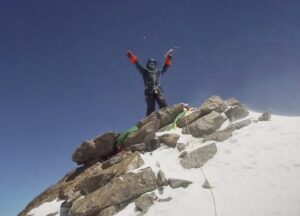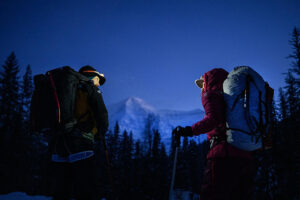Maarten van Haeren and Ethan Berman wanted something special for their first Himalayan climbing experience. They found it in eastern Nepal’s Rolwaling, along the Tibetan border. There, the Canadian pair forged a new 1,200m route up Khang Karpo (6,646m).
They called their new line Tiny Changes and graded it TD+ M5 AI4. It is the first ascent of the northeast face, as well as the first time the mountain has been climbed from the rarely visited Chulle Glacier basin.
“As far as we could tell, the last climbing expeditions in this valley were a Japanese team that made the first official ascent of Dingjung Ri South in 2008 and Andy Parkin in winter 2010,” van Haeren told ExplorersWeb. “The tallest and most imposing peaks in the valley were Dragnag Ri (6,757m) and Khang Karpo (6,647m).”
A few photos convinced them that Khang Karpo was safer and more aesthetic.

Left to right, Dragnag Ri (6,757m) and Khang Karpo (6,646m), with Melungtse (7,181m) in the background, in Tibet. Photo: Maarten van Haeren
From the Khumbu to Rolwaling
Outfitted by Climb High Himalaya, van Haeren and Berman first trekked up the Khumbu. After all, it was their first time in Nepal. The two climbers then set off from Namche Bazaar through Thame to Rolwaling via the Three Passes Trek.
“One more day of hiking with the yaks saw us arrive in base camp at 4,900m,” they reported. “A beautiful small meadow, with a large overhanging boulder that made a great camp kitchen.”
Unfortunately, both came down with flu symptoms on the trek, so their first five-day acclimatization trip in the area was uncomfortable. Still, they managed to get to 5,850m on the first round and above 6,000m on the second.
“It was hard to reach that altitude for acclimatization without either hard climbing, exposing ourselves to considerable objective hazard, or the most dangerous option — crossing into Tibet.”
For political reasons, Tibet is closed to foreigners.
On their final acclimatization, they tried the lower part of Khang Karpo via its northeast face. It was a good way to gain altitude and also to check conditions.
“It also introduced us to the deep cold on this northeast face, with lots of boot-swinging and living in our full puffy kit, even while climbing,” Van Haeren said.
After some days of rest, they felt ready. Van Haeren was still coughing but he improved as he gained altitude.
Into the unknown
They set off on November 3, with seven ice screws, a small rock rack, a tent, a sleeping kit, and food for five days. They had no idea what lay ahead of them.
“We spent the first day approaching the mountain, with help from [Base Camp manager] Namgyal Sherpa. We then headed onto the glacier below the northeast face.”
On that first day, the climbers had to adapt their schedules to the characteristics of the wall they were climbing. Since it faced east, the morning sun destabilized the snow and ice, so they waited until 11 am before starting to climb.

“The second day we headed up the lower ice face to a bivy underneath a sheltered cliff [and] dug into the 60º steep snow slope,” Van Haeren said.
The next (very cold) morning, the pair started at daybreak. They traversed a steep snow slope at 6,000m, with Berman leading.
“What we had hoped would be a relatively easy and safe start, quickly turned less pleasant, as the traverse was poorly protected,” they explained. With no proper place to set an anchor, Berman had to continue forward along the whole exhausting traverse.
“We were both cold from the slow progress when I took over,” Van Maeren said. “Several mixed pitches brought us below our intended break through the first major rock band…We followed good ice to the left for another four or five pitches [until almost] the end of daylight.”
Changing the route on the go
It was “good luck,” the climbers recall, that they found a huge snow mushroom below an overhanging rock section at 6,300m. Here, they could dig a platform for their tent, “with only a small part of the tent hanging off the ledge.”
By then, the pair had deviated from their intended line. The next morning, they again changed their line. Instead of climbing through the rock shield above, they headed straight up the tallest part of the face to the summit glacier. They were almost there.

The last metres to the top. Photo: Maarten van Haeren
On summit morning, “we collapsed the tent, left our sleeping kit and stove, and started up with light packs,” Van Maeren recalls. “Ethan led all the pitches this last day, following mostly good ice or poor snow, through our crux pitch and into the final ice groove.”
Reaching the summit after just 50 vertical metres on glacial terrain, was pure joy. The climbers shared hugs, handshakes, and tears on a clear, sunny day. They stood right on the border between Nepal and Tibet, with five 8,000m peaks in plain view.
“Truly, a lifetime of climbing in one view,” they said.
Down the same way

Route topo. Photo: van Haeren/Berman
It took them two days to descend the same route that they’d climbed.
“The south descent seemed objectively hazardous and the north descent would put us in Tibet,” van Haeren explained.
“For us, this was a great stepping stone into more technical alpinism at altitude. Though both Ethan and I have made trips to Alaska and Mount Logan, and Ethan has been to Bolivia, Khang Karpo was our first Himalayan trip. It was higher and more technical than our previous climbs. We learned many things about ourselves and alpine climbing at altitude by picking a more remote objective with less information.”






